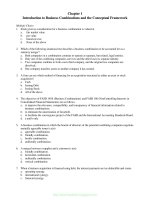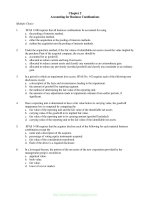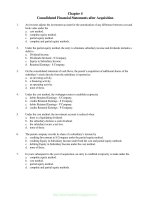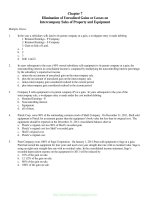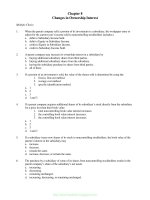advanced accounting 6e by jeter chaney chapter 02
Bạn đang xem bản rút gọn của tài liệu. Xem và tải ngay bản đầy đủ của tài liệu tại đây (1.25 MB, 60 trang )
Advanced Accounting
Jeter ● Chaney
Accounting for Business
Combinations
1
Prepared by Sheila Ammons, Austin Community College
Learning Objectives
•
•
•
•
Describe the major changes in the accounting for business combinations passed by the FASB in
December 2007, and the reasons for those changes.
Describe the two major changes in the accounting for business combinations approved by the
FASB in 2001, as well as the reasons for those changes.
Discuss the goodwill impairment test, including its frequency, the steps laid out in the new
standard, and some of the implementation problems.
Explain how acquisition expenses are reported.
2
Copyright © 2015. John Wiley & Sons, Inc. All rights reserved.
Learning Objectives
•
•
Describe the use of pro forma statements in business combinations.
•
Explain how contingent consideration affects the valuation of assets acquired in a business
combination accounted for by the acquisition method.
•
•
•
Describe the valuation of assets, including goodwill, and liabilities acquired in a business
combination accounted for by the acquisition method.
Describe a leveraged buyout.
Describe the disclosure requirements according to current GAAP related to each business
combination that takes place during a given year.
Describe at least one of the differences between U.S. GAAP and IFRS related to the accounting
for business combinations.
3
Copyright © 2015. John Wiley & Sons, Inc. All rights reserved.
Historical Perspective on Business Combinations
What Changed?
•
Issued December 2007
SFAS No. 141R [ASC 805], “Business Combinations,” replaced FASB Statement No. 141.
– Supports the use of a single method.
– Uses the term “acquisition method” rather than “purchase method.”
– The fair values of all assets and liabilities on the acquisition date, defined as the date the
acquirer obtains control of the acquiree, are reflected on the financial statements.
4
LO 1 FASB’s two major changes for business combinations.
Copyright © 2015. John Wiley & Sons, Inc. All rights reserved.
Historical Perspective on Business Combinations
What Changed?
•
Issued December 2007
“Noncontrolling Interests In Consolidated
Financial Statements”, amended Accounting Research Bulletin (ARB) No. 51. (now
included in FASB ASC 810 [Consolidations]),
– Established standards for the reporting of the noncontrolling interest when the acquirer
obtains control without purchasing 100% of the acquiree.
– Additional discussion in Chapter 3.
5
LO 1 FASB’s two major changes for business combinations.
Copyright © 2015. John Wiley & Sons, Inc. All rights reserved.
Accounting Standards on Business Combinations:
Historical Perspective on Business Combinations
Background
•
•
Historically, two methods permitted in the U.S.: purchase and pooling of interests.
Pronouncements in June 2001:
– SFAS No. 141, “Business Combinations,” - pooling method is prohibited for business
combinations initiated since June 30, 2001. [FASB ASC 805]
– SFAS No. 142, “Goodwill and Other Intangible Assets,” - Goodwill acquired in a business
combination since June 30, 2001, should not be amortized. [FASB ASC 350]
LO 2 FASB’s two major changes of6 2001.
Copyright © 2015. John Wiley & Sons, Inc. All rights reserved.
Accounting Standards on Business Combinations:
Background
Goodwill Impairment Test
•
For public companies, goodwill is no longer amortized.
•
Private companies can elect an alternative model: amortize goodwill over a period not to
exceed 10 years and utilize a simplified impairment model.
– Goodwill of each reporting unit is tested for impairment on an annual basis.
• All goodwill must be assigned to a reporting unit.
• Impairment should be tested in a two-step process.
– Step 1: Does potential impairment exist?
– Step 2: What is the amount of goodwill impairment?
Issued January 2014
7
LO 3 Goodwill impairment assessment.
Copyright © 2015. John Wiley & Sons, Inc. All rights reserved.
Perspective on Business
Combinations
8
Copyright © 2015. John Wiley & Sons, Inc. All rights reserved.
LO 3
Goodwill
Impairment
Test
Goodwill Impairment
Test
E2-10: On January 1, 2013, Porsche Company acquired the net assets of Saab Company for $450,000 cash. The fair value of
Saab’s identifiable net assets was $375,000 on this date. Porsche Company decided to measure goodwill impairment using the
present value of future cash flows to estimate the fair value of the reporting unit (Saab). The information for these subsequent
years is as follows:
*
* Goodwill is not included
9
LO 3 Goodwill impairment assessment.
Copyright © 2015. John Wiley & Sons, Inc. All rights reserved.
Goodwill Impairment Test
E2-10: On January 1, 2013, the acquisition date, what was the amount of goodwill acquired, if any?
Acquisition price
$450,000
Fair value of identifiable net assets
375,000
Recorded value of Goodwill
$ 75,000
10
LO 3 Goodwill impairment assessment.
Copyright © 2015. John Wiley & Sons, Inc. All rights reserved.
Goodwill Impairment Test
E2-10: Part A&B: For each year determine the amount of goodwill impairment, if any, and prepare the journal entry needed
each year to record the goodwill impairment (if any).
Step 1 - 2014
Fair value of reporting unit
$400,000
Carrying value of unit:
Carrying value of identifiable net assets
Carrying value of goodwill
330,000
Total carrying value of unit
75,000
Excess of carrying value over fair value
405,000
$ 5,000
Excess of carrying value over fair value means step 2 is required.
11
LO 3 Goodwill impairment assessment.
Copyright © 2015. John Wiley & Sons, Inc. All rights reserved.
Goodwill Impairment Test
E2-10: Part A&B (continued)
Step 2 - 2014
Fair value of reporting unit
$400,000
Fair value of identifiable net assets
340,000
Implied value of goodwill
60,000
Carrying value of goodwill
75,000
Impairment loss
$ 15,000
Journal
Entry
Impairment Loss Goodwill
15,000
Goodwill
15,000
12
LO 3 Goodwill impairment assessment.
Copyright © 2015. John Wiley & Sons, Inc. All rights reserved.
Goodwill Impairment Test
E2-10: Part A&B (continued)
Step 1 - 2015
Fair value of reporting unit
$400,000
Carrying value of unit:
Carrying value of identifiable net assets
Carrying value of goodwill
320,000
*
Total carrying value of unit
60,000
Excess of fair value over carrying value
380,000
$ 20,000
Excess of fair value over carrying value means step 2 is not required.
* $75,000 (original goodwill) – $15,000 (prior year impairment)
13
LO 3 Goodwill impairment assessment.
Copyright © 2015. John Wiley & Sons, Inc. All rights reserved.
Goodwill Impairment Test
E2-10: Part A&B (continued)
Step 1 - 2016
Fair value of reporting unit
$350,000
Carrying value of unit:
Carrying value of identifiable net assets
Carrying value of goodwill
300,000
*
Total carrying value of unit
60,000
Excess of carrying value over fair value
360,000
$ 10,000
Excess of carrying value over fair value means step 2 is required.
* $75,000 (original goodwill) – $15,000 (prior year impairment)
14
LO 3 Goodwill impairment assessment.
Copyright © 2015. John Wiley & Sons, Inc. All rights reserved.
Goodwill Impairment Test
E2-10: Part A&B (continued)
Step 2 - 2016
Fair value of reporting unit
$350,000
Fair value of identifiable net assets
325,000
Implied value of goodwill
25,000
Carrying value of goodwill
60,000
Impairment loss
$ 35,000
Journal
Entry
Impairment Loss Goodwill
35,000
Goodwill
35,000
15
LO 3 Goodwill impairment assessment.
Copyright © 2015. John Wiley & Sons, Inc. All rights reserved.
Goodwill Impairment Test
Review Question
•
The first step in determining goodwill impairment involves comparing the
a)
b)
c)
d)
implied value of a reporting unit to its carrying amount (goodwill excluded).
fair value of a reporting unit to its carrying amount (goodwill excluded).
implied value of a reporting unit to its carrying amount (goodwill included).
fair value of a reporting unit to its carrying amount (goodwill included).
16
LO 3 Goodwill impairment assessment.
Copyright © 2015. John Wiley & Sons, Inc. All rights reserved.
Goodwill Impairment Test
Disclosures Mandated by FASB
•
FASB ASC paragraph 805-30-50-1 requires:
– Total amount of acquired goodwill and the amount expected to be deductible for tax
purposes.
– Amount of goodwill by reporting segment (if the acquiring firm is required to disclose
segment information), unless not practicable.
17
LO 3 Goodwill impairment assessment.
Copyright © 2015. John Wiley & Sons, Inc. All rights reserved.
Goodwill Impairment Test
Disclosures Mandated by FASB
•
FASB ASC paragraph 350-20-45-1 specifies the presentation of goodwill (if impairment
occurs):
– Aggregate amount of goodwill should be a separate line item in the balance sheet.
– Aggregate amount of losses from goodwill impairment should be a separate line item in the
operating section of the income statement unless some of the impairment is associated with
a discontinued operation.
18
LO 3 Goodwill impairment assessment.
Copyright © 2015. John Wiley & Sons, Inc. All rights reserved.
Goodwill Impairment Test
Disclosures Mandated by FASB
•
When an impairment loss occurs, FASB ASC paragraph 350-20-50-2 mandates note
disclosure:
– Description of facts and circumstances leading to the impairment.
– Amount of impairment loss and method of determining the fair value of the reporting unit.
– Nature and amounts of any adjustments made to impairment estimates from earlier periods,
if significant.
19
LO 3 Goodwill impairment assessment.
Copyright © 2015. John Wiley & Sons, Inc. All rights reserved.
Perspective on Business Combinations
Other Required Disclosures
•
FASB ASC paragraph 805-10-50-2 states that disclosure should include:
– The name and a description of the acquiree.
– The acquisition date.
– The percentage of voting equity instruments acquired.
– The primary reasons for the business combination, including a description of the factors
that contributed to the recognition of goodwill.
20
LO 9 New disclosure requirements for business combinations.
Copyright © 2015. John Wiley & Sons, Inc. All rights reserved.
Perspective on Business Combinations
Other Required Disclosures
•
FASB ASC paragraph 805-10-50-2 states that disclosure should include:
– The fair value of the acquiree and the basis for measuring that value on the acquisition date.
– The fair value of the consideration transferred.
– The amounts recognized at the acquisition date for each major class of assets acquired and
liabilities assumed.
– The maximum potential amount of future payments the acquirer could be required to make.
21
LO 9 New disclosure requirements for business combinations.
Copyright © 2015. John Wiley & Sons, Inc. All rights reserved.
Perspective on Business Combinations
Other Intangible Assets
•
Acquired intangible assets other than goodwill:
– Limited useful life
• Should be amortized over its useful economic life.
• Should be reviewed for impairment. FASB ASC Section 350-30-35
– Indefinite life
• Should not be amortized.
• Should be tested annually (at a minimum) for impairment.
22
LO 3 Goodwill impairment assessment.
Copyright © 2015. John Wiley & Sons, Inc. All rights reserved.
Perspective on Business Combinations
Treatment of Acquisition Expenses
•
FASB ASC paragraph 805-10-25-23 excludes acquisition-related from measurement of
consideration paid.
– Both direct and indirect costs are expensed
– The cost of issuing securities is excluded from the consideration.
• Security issuance costs are assigned to the valuation of the security, thus reducing the
additional contributed capital for stock issues or adjusting the premium or discount
on bond issues.
– Expected restructuring costs (with no obligation at the acquisition date) are accounted for
separately from the business combination.
23
LO 4 Reporting acquisition expenses.
Copyright © 2015. John Wiley & Sons, Inc. All rights reserved.
Perspective on Business Combinations
Acquisition Costs—an Illustration
Suppose that SMC Company acquires 100% of the net assets of Bee Company (net book value of $100,000) by issuing shares of
common stock with a fair value of $120,000. With respect to the merger, SMC incurred $1,500 of accounting and consulting costs and
$3,000 of stock issue costs. SMC maintains a mergers department that incurred a monthly cost of $2,000. Prepare the journal entry to
record these costs.
Professional Fees Expense (Direct)
1,500
Merger Department Expense (Indirect)
2,000
Other Contributed Capital (Security Issue Costs) *
3,000
Cash
6,500
*Costs to issue debt or equity securities shall be recognized in accordance with other applicable GAAP - FASB ASC
805-10-25-23:
24
LO 4 Reporting acquisition expenses.
Copyright © 2015. John Wiley & Sons, Inc. All rights reserved.
Pro Forma Statements and Disclosure Requirement
Pro forma statements (as-if statements) serve two functions in relation to business combinations:
– to provide information in the planning stages of the combination and
– to disclose relevant information subsequent to the combination.
25
LO 5 Use of pro forma statements.
Copyright © 2015. John Wiley & Sons, Inc. All rights reserved.


